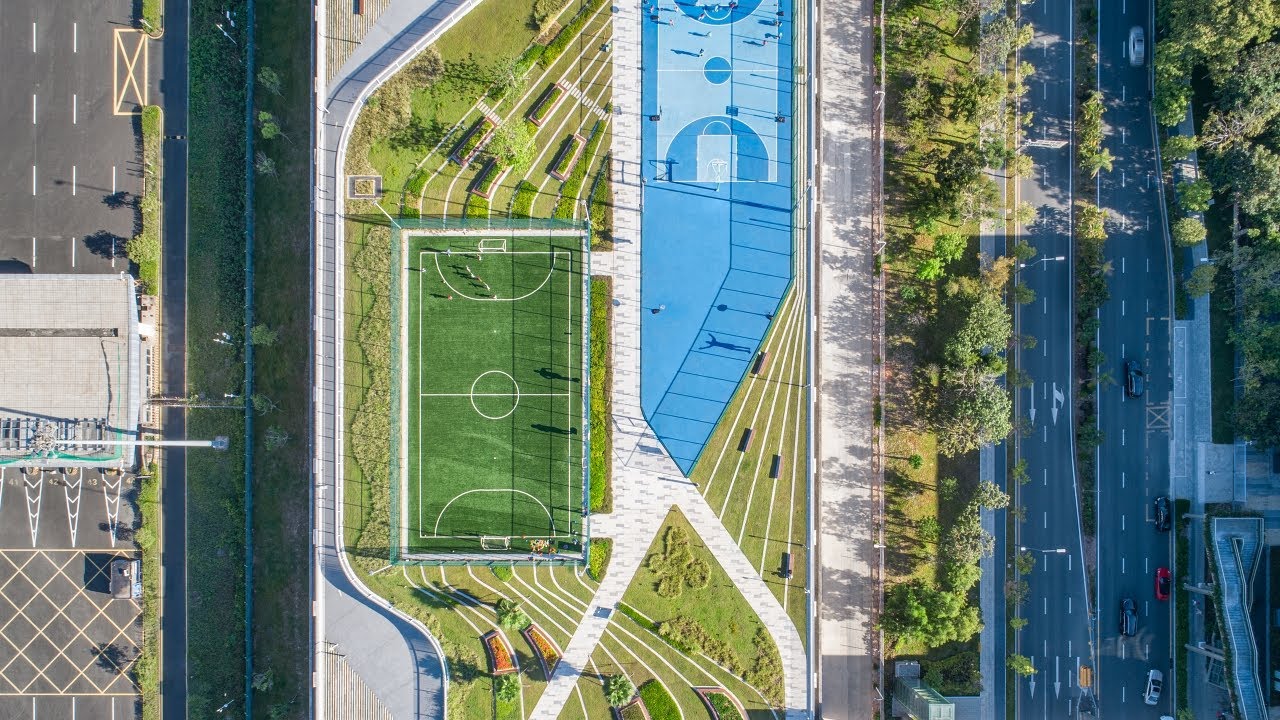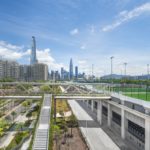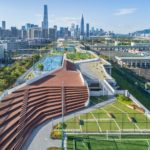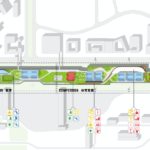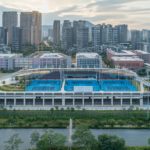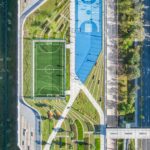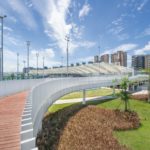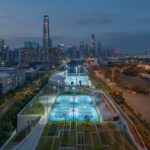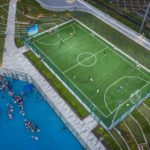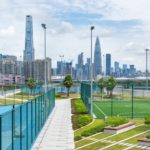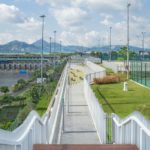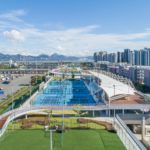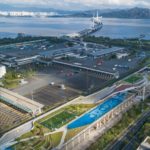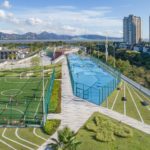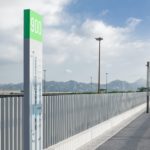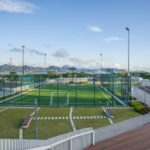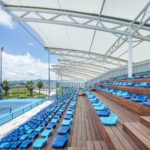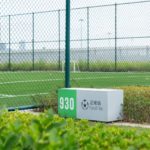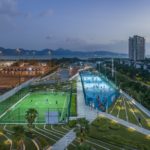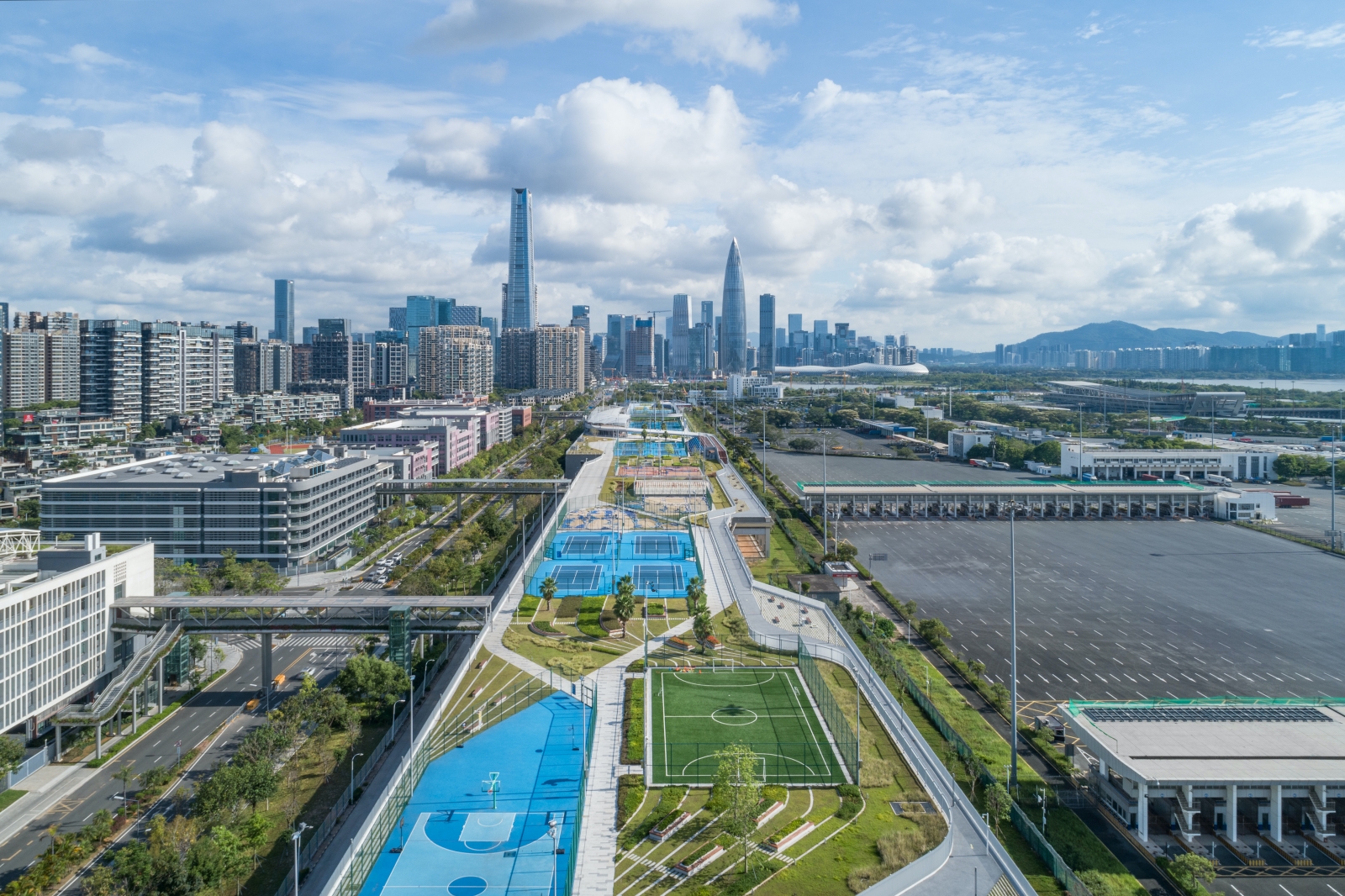
Additional Resources
For more information on the Shenzhen Skypark, contact Crossboundaries at M +86-10-64012553 and media@crossboundaries.com.
Case Studies
Video
Watch the December 9, 2021 3:49 Shenzhen Skypark – Featured Project video from Greenroofs.com on the greenroofsTV channel on YouTube; 2:53 Shenzhen Skypark video from Crossboundaries.
News
December 9, 2021 Featured Project: Shenzhen Skypark, China by Linda Velazquez in Greenroofs.com.
A fusion of infrastructure, architecture and urban landscape, the Shenzhen Skypark revalues a former unused rooftop, converting it into a recreational urban strip integrating sports and playscape in the Nanshan District of Shenzhen, China.
Designed by the international partnership of Crossboundaries, the main goal of the project was to make use of the existing, yet previously underutilized rooftop area, and to better integrate the building into the fabric of its surroundings, while simultaneously rethinking the civic function of urban design in the 21st century.
Over the past 40 years, Shenzhen has developed from a tiny fishing village to one of the most innovative, modern cities in China. With a rapid population growth, from just a few thousand to nearly 17 million inhabitants today, it has evolved into a thriving megalopolis. More than 33% of its very young population – averaging just under 30 years old – lives in these densely populated metropolitan surroundings, hence urban parks, as well as spaces for leisure and recreation, are essential components of a green infrastructure that helps contribute to the well-being of local communities. With Shenzhen’s comfortable year-round climate, these outdoor recreational spaces can be utilized to their fullest potential.
One of the areas the local government had identified to be transformed into a sports & leisure zone was the 1.2 km long rooftop of the Southern Terminal and Depot building of Shenzhen’s Metro Line 2, which leads to Shekou, a major crossing point to neighboring Hong Kong by ferry, bus, car, or train.
One of the challenges was to accommodate the needs of different user groups: first, to improve the quality of physical education in the surrounding schools, second, to provide places for the general public to enjoy leisurely sports, and third, to establish facilities for professional sports events and competitions with an audience.
Crossboundaries partnered with the Shenzhen Nanshan District Government to focus on the development of the roof surface as a refurbishing measure, upgrading the existing Shenzhen Metro line 2 Depot and creating an elevated sports and leisure park on top of it.
The actual depot itself is primarily used for maintenance of the Metro trains (cleaning, repair, technical inspections, etc.), and also contains administrative spaces, including a crew center, a signal office, equipment rooms, etc.
The realized concept consists of a sequenced stretch of several sports facilities, combined with a park for recreation, built on an existing part of the city’s infrastructure. In line with the original intention of the architects, a public, accessible space was created, complementing a previously fragmented urban context.
In the initial analysis of the project requirements and the original site, Crossboundaries set out to address three main aspects:
Shenzhen Skypark Contextual Consistency – on a Macro, Meso, Micro Level
The architects started with a review of the overall urban context of the project (macro). Next, they gradually zoomed in on the local circumstances of the site to examine the surrounding educational, commercial, and residential facilities in relation to potential accesses and connections between the river and the bay area (meso). Finally, on the given design site, they also reassessed the existing Metro terminal building, including its parking area (micro).
The first challenge faced was the long 1.2 km stretch of the building complex. With an overall height of about 15m, and a width of 70m at the widest and 50m at the narrowest point, the original complex completely cut off nearby neighborhoods from the bay, neither adding any aesthetic value, nor serving a specific functional purpose.
The next consideration was how to integrate the new sports and leisure zone into its surroundings, and how to connect it with residential and educational buildings located in the immediate neighborhood. This also became part of the overall investigation, although the implementation of fly-overs, bridges, and corridors was not part of the initial scope, nor the first phase of construction.
Furthermore, the overall roof surface area of 73,000 m2 (with a total project area close to 77,000 m2) was intended to provide spatial solutions for both open and enclosed zones to allow for more dynamic activities (e.g., sports, competitions, and supporting facilities), as well as for more static, “quiet” activities (e.g., recreation, enjoyment of nature).
“We were confronted with very exceptional circumstances”, explains Hao Dong, co-founder and partner at Crossboundaries, “In China, infrastructure and traffic-related areas usually belong to the government and are not meant to be assigned any public use at all. This elongated rooftop presented itself with huge potential to be transformed into a usable park, accessible to a wider public and enriching the urban environment around it.”
Approximately 33% of the overall roof area is vegetated, or about 22,000 sqm which is equivalent to approximately 237,000 sqf. The majority of the roof park is occupied by the different sport fields, pathways, etc., and other areas.
Plants and vegetation were selected according to the local climate and grow well all year around. Since the building was an existing infrastructure, too much extra weight could not be added overall. Structures had to be balanced (bleachers for example) as well as plantings, therefore no heavy trees and no deep soil were added.
Intertwined Programmatic Functions – A Catalyst Platform
Three specific user groups were identified as beneficiaries of the new project development – the general public, local professional sports clubs (tennis and volleyball in particular), and three educational institutions: the Shenzhen Nanshan Foreign Language School and the Shenzhen Bay School, comprised of Elementary and Junior High programs.
Crossboundaries proposed to subdivide the plot into three programmatic zones for the three different user groups, all of which tightly link with their immediate surroundings: one for the general public, for social & cultural interaction; one exclusively for use by the adjacent schools, fulfilling educational functions; and one for professional sports, for training activities and hosting of competitions with an audience.
Special emphasis was put on the fact that all three user scenarios can take place in parallel. The dedicated areas need to allow for closing for more limited audiences, or broader opening for bigger audiences at certain times.
Each of the programmatic areas was developed with a varied and balanced mix of sports, leisure, support & service (changing rooms, coach and referee areas), and green functions, resulting in an overall integrated sports and playscape.
The segmentation of the long, stretched sports park was influenced by the adjacent educational institutions. Ultimately, the architects divided the rooftop stretch into five segments: the northernmost part is dedicated to the Shenzhen Nanshan Foreign Language School, followed by the Professional Sports Competition and Training zone. Next are the facilities for Shenzhen Bay School’s North and South Campuses, and finally there is an area dedicated to the general public for leisure, fitness, and the enjoyment of greenery. In a functional sense, the strip satisfies the needs of multiple user groups for sport and leisure facilitation, becoming a linear recreation hub serving the neighborhood.
In total for all of the schools, five tennis and six basketball courts, as well as two Five-a-side fields, were placed. Several running tracks (460m, 160m, and a straight 200m track) were also added. The competition and training area for professionals was equipped with two lawn courts, six competitive tennis courts, four training and two clay courts, and two volleyball courts. The community segment features green areas, as well as a full-size soccer field.
Access and Connections
All entrances and accesses to the rooftop park are located in direct vicinity to different functional areas, while preventing unnecessary interference, and are reachable via six access points in total.
Vertical connections make the North and the South end directly accessible from the ground floor, inviting the general public up to the roof area. School access occurs exclusively via crossovers leading directly onto the rooftop. They are attached to three secondary public entrances, in the form of elevators and staircases, for additional access from the street level.
On the rooftop itself, circulation is facilitated by three main paths that occasionally intersect, connect, and “grow” into other functions: Leisure path, Pedestrian path, and Sports path (running/skating). The paths are also distinguished by their materials. Most of the pedestrian walkway is paved with stone, while the leisure trail is mostly covered with timber. The sports track features a rubber surface.
Orientation on a Human Scale
The development of a wayfinding and signage system along a very long strip, like in the case of the Shenzhen Bay project, has to facilitate navigation and overcome the seemingly repetitive character of an extremely linear site.
Applying the results of the previous analysis, Crossboundaries designed a signage system applied on a macro, meso, and micro scale.
Macro scale signage is assigned to the entrances, highlighting them and ensuring that they are visible from the ground floor, and from a distance.
Meso scale signs are deployed along the strip and help users to orient themselves (and each other) on the long, linear platform. Signage pylons are placed in 100m increments along the strip, indicating the facilities that are located in that very stretch, and providing an idea of one’s position relative to the North and the South entrance. The top parts of the pylons have numbers – 100, 200, 300, etc. – marking the distance one has walked.
Finally, micro scale signs identify specific destinations within those 100m marks. They define meeting points, while at the same time serving as functional objects in the form of benches, light cubes, garbage cans, and the like.
An Ever-changing Experience
As the sports strip is an attractive addition to the urban neighborhood offering a variety of recreational options, it attracts users of all profiles and ages, ensuring that the area is used throughout the day by a diverse audience. The strip also adds a visual experience from the Skypark itself, from which the surrounding urban landscapes, the Shenzhen skyline, and the Bay area can be enjoyed. Inhabitants of the nearby residential compounds also benefit from beautiful views towards the East overlooking Crossboundaries’ design of the roof park.
Crossboundaries’ concept brings educational institutions together with the local community in a unique combination of sports and recreational offers, tied together with the landscape. Additionally, it makes use of utilizing the local panorama, capturing vistas towards the sea and presenting an ever-changing experience. The partially elevated recreational trail not only integrates the supporting facilities, but also provides an excellent place to view competitions and training sessions, and to enjoy the views of Shenzhen Bay.
Humanization & Diversification
Crossboundaries’ design language distinguishes itself once more through the integration of predominantly human aspects. All of this becomes visible, not only in the overall functional layout connecting communities and facilitating different usage scenarios, but also through the choice of materials and the application of environmental and sustainable principles. The project uses an abundance of wood, including all the tribunes in the stadium. There is also an abundance of green areas, abundant light, and permeable architectural structures, not only for buildings, but also for bridges and rails. The greenery planted along the pathways provide shade, while also contributing to efficient drainage and microclimate conditions.
Crossboundaries’ solution is a green accent in its surroundings which aims to enable a healthy urban lifestyle that goes hand-in-hand with the city’s youthful, entrepreneurial, and dynamic character. The roof park development has become an attractive addition to the urban neighborhood, interwoven in its infrastructure and seen as a community jewel that many of the surrounding high-rise buildings have a direct view upon.
“Our linear park is like a missing puzzle that plugs into the neighboring communities,” concludes Binke Lenhardt, the other co-founder of Crossboundaries. “It creates the necessary physical and visual link between the urban tissue and the seaside and, along the way, aims to satisfy the schools’ and the public’s ever growing need for recreational spaces and room to breathe in a dense, urban environment.”
Tasked to develop such a large scaled sports and recreational park rooftop, Crossboundaries created an essential meeting point in Shenzhen that enhances social and cultural interaction between different groups of Shenzhen’s diverse urban population. The Shenzhen Skypark project succeeds in fulfilling its educational mandate and advocates for sports and wellness in general in a densely populated urban space.
Shenzhen Skypark Quick Facts
Roof total length: 1.2km
Roof width: 50m -70 m
Planned total area: 77,000 sqm
Vegetated total area: 33%
Design time: May 2016 -July 2017
Construction time: March 2018 -June 2021
Completion time: July 2021
 Greenroofs.comConnecting the Planet + Living Architecture
Greenroofs.comConnecting the Planet + Living Architecture
